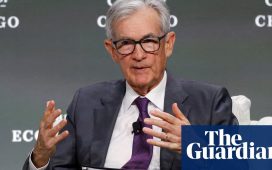Key events
Stocks slide while oil prices rise
Stock markets are sliding in Europe, following in Asia’s footsteps, while oil prices have risen slightly.
The FTSE 100 index is down almost 1% at 7,900, and has only three risers at the moment: artificial hips and knees maker Smith & Nephew, British Gas owner Centrica, and the oil giant Shell.
The German, French and Italian stock markets have lost more than 1%. In Asia, Japan’s Nikkei closed almost 2% lower while Hong Kong’s Hang Seng was little changed, and the South Korean market fell 1%.
Meanwhile, Brent crude, the global oil benchmark, is trading 0.2% higher at $90.84 a barrel, closing in on $91.
Sophie Lund-Yates, lead equity analyst at Hargreaves Lansdown, said:
The FTSE 100 has gone backwards on its last trading day of the week, as investors digest PMI data as well as a downbeat tone over in the US. The major indices all shed between 1.2-1.4% on Thursday, with broad based declines suggesting the malaise is a widespread mood problem, rather than a sector specific issue.
Investors are now looking ahead to today’s US job data which will highlight the strength of the labour market. The narrative around the potential for interest rate cuts has been slightly contradictory this week, so there’s a lot resting on this data to help steady the ship. A looser labour market could help back the argument that the economy is returning to more stable footing.
There is a fly in the ointment, in the form of the storming oil price. This is adding real inflationary concerns back into the market, and isn’t helped by the significant uncertainty that comes with geopolitical tensions.
Brent crude is close to $91 a barrel, as efforts to instigate peace in the Middle East have gone unrewarded. Ongoing reduced supply mandates from OPEC+ are also causing upset to the price. Strong US data has boosted demand expectations too. Fundamentally, oil prices are cyclical, with ups and downs always to be expected. However, the trajectory of the price has been particularly bumpy in recent years and it’s unclear when this will smooth out over the longer-term.
AstraZeneca’s Imfinzi shows promise in treating aggressive lung cancer
Britain’s biggest drugmaker AstraZeneca has received a boost, as its blockbuster cancer drug Imfinzi showed positive results as a treatment for aggressive lung cancer in a late-stage clinical trial.
The drug demonstrated a “statistically significant and clinically meaningful improvement” in both the overall survival of patients with limited-stage small cell lung cancer, and the survival of of patients without the disease progressing.
Small cell lung cancer is a highly aggressive form of cancer that typically recurs and progresses rapidly despite initial response to chemotherapy and radiotherapy, with only 15%-30% of these patients alive five years after diagnosis, AstraZeneca said.
Susan Galbraith, executive vice president of oncology research & development at the drugmaker, said:
These exciting results build on the transformative efficacy of Imfinzi in extensive-stage small cell lung cancer and demonstrate the potential to bring a curative-intent immunotherapy treatment to this earlier-stage setting of small cell lung cancer for the first time.
These data… underscore the pioneering role of Imfinzi in the treatment of early lung cancer following chemoradiotherapy.
After ramping up research spending and through a series of smart bets, AstraZeneca has built up a portfolio of cancer drugs that accounts for almost a quarter of the company’s annual revenues.
Imfinzi is already approved for another type of lung cancer as well as gallbladder and liver cancer. However, the drug suffered a setback in a trial in November aimed at expanding its use for another terminal lung cancer.
The firm is hoping that Imfinzi will become a treatment option for more than half of lung cancer patients by 2030.
Imogen Pattison, assistant economist at Capital Economics, said:
The first decline in the Halifax house price index in six months confirmed that the slight rise in mortgage rates since the start of the year has caused house prices to stall.
Looking ahead, we expect mortgage rates to remain higher than in January and February and hover at just under 5% over the coming months, which will subdue demand and prevent further gains in house prices. But given public house price expectations are positive, we doubt prices will fall much either.
And if we are right to think that Bank Rate will be cut further than most forecasters anticipate, mortgage rates will fall to below 4% by this time next year, giving house prices a fresh boost.
Anthony Codling, housing analyst at RBC Capital Markets, said:
Mortgage approvals are increasing, wages are rising, and in our view mortgage rates are more likely to fall than rise in the coming months, therefore looking forward we believe the housing markets glass to be half full rather than half empty.
The housebuilders we speak to are confirming our view that consumer confidence is rising and that many of those who delayed their purchasing plans as mortgage rates rose are now taking those plans off ice.
Growing confidence is likely to improve the growth of UK housebuilders’ forward order books which started the year lower than normal, and if current trends continue, this year’s spring selling season could be a very pleasant one.
Housebuilders entered the year with lower than normal forward order books. Empirically there is little correlation between opening order books and full year volumes. Yes the housebuilders have more work to do, but history suggests that they are both willing and able to rise to the challenge especially as, for now, it appears they have the wind behind them rather than ahead of them.
The Halifax survey shows that Northern Ireland remained the region or nation with the highest house price growth in the UK – with prices up by 4.3% on an annual basis. Properties in Northern Ireland now cost an average of £194,743, which is £7,972 more than a year ago.
In Wales, annual price growth slowed to 1.9% in March, from 3.9% in February, with the average home now costing £219,213. Scottish house prices rose 2.1% year-on-year to stand at £204,835.
There is something of a north/south divide in England, with the North West posting the strongest growth, of 3.7% on an annual basis to £232,315.
Properties in eastern England recorded the biggest decline of -0.9%, with homes selling for an average of £330,627, a drop of £2,878 over the last year.
London continues to have the highest average house price in the UK, at £539,917. Prices in the capital have increased by 0.4% over the last year.
Introduction: UK House prices fall for first time in six months
Good morning, and welcome to our rolling coverage of business, the financial markets and the world economy.
House prices across the UK fell by 1% last month following five months of growth, according to Britain’s biggest mortgage lender.
A typical home now costs £288,430, around £2,900 less than last month, said Halifax, which is part of Lloyds Banking Group. The monthly drop, the first since September, came after a 0.3% gain in February.
Compared with a year earlier, prices rose 0.3%, compared to 1.6% last month.
A rival survey from Nationwide building society showed that the average UK house price fell by 0.2% month on month in March.
Kim Kinnaird, director of mortgages at Halifax, said:
That a monthly fall should occur following five consecutive months of growth is not entirely unexpected, particularly in view of the reset the market has been going through since interest rates began to rise sharply in 2022. Despite this house prices have shown surprising resilience in the face of significantly higher borrowing costs.
Affordability constraints continue to be a challenge for prospective buyers, while existing homeowners on cheaper fixed-term deals are yet to feel the full effect of higher interest rates. This means the housing market is still to fully adjust, with sellers likely to be pricing their properties accordingly.
Financial markets have also become less optimistic about the degree and timing of Base Rate cuts, as core inflation proves stickier than generally expected. This has stalled the decline in mortgage rates that had helped to drive market activity around the turn of the year.
Markets are pricing in a potential first cut in interest rates by June, and a total of three quarter-point reductions by December.
The broader picture is that prices are up year-on-year, reflecting the opposing forces of an easing cost off living squeeze and relatively high interest rates, she said.
Kinnaird predicted that the housing market will remain subdued this year:
Taking a slightly longer-term view, prices haven’t changed much over the past couple of years, moving in a narrow range since the spring of 2022, and are still almost £50,000 above pre-pandemic levels.
Looking ahead, that trend is likely to continue. Underlying demand is positive, as greater numbers of people buy homes, demonstrated by recent rises in mortgage approvals across the industry and underpinned by a strong labour market. And with rental costs rising at record rates, home ownership continues to be an attractive option for those who can make the sums work.
However the housing market remains sensitive to the scale and pace of interest rate changes, and with only a modest improvement in affordability on the horizon, this will likely limit the scope for significant house price increases this year.
Train drivers in England begin a three-day series of strikes today.
Rail passengers across England will face significant disruption as train drivers at five operating companies carry out industrial action.
The 24-hour strike will be the first of three days of rolling strike action being taken by the train drivers’ union Aslef, with services on Avanti West Coast, CrossCountry, East Midlands Railway, London Northwestern Railway and West Midlands Railway all affected.
The five companies have said they will not be running any services throughout Friday and warned that services on Saturday could also be affected.
At lunchtime, we’ll get the latest US unemployment figures.
The Agenda
-
1.30pm BST: US non-farm payrolls for March (forecast: 200,000)
-
1.30pm BST: US jobless rate for March (forecast: 3.9%)








